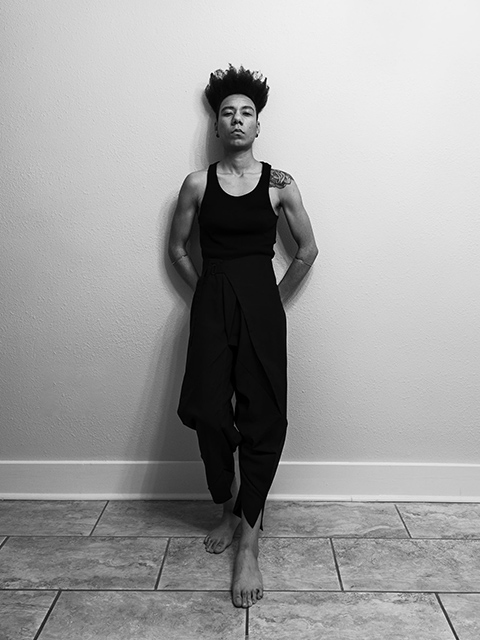On 15 May 2025, flames ripped through Nottoway Plantation, a mansion in Louisiana USA. Built by enslaved labourers in 1859 for the sugar baron John Hampden Randolph, Nottoway was the largest plantation house still standing in the Southern United States. In recent years, the plantation has served as a resort destination, wedding venue and tourist attraction.
Reportedly caused by an electrical fault, the fire has sparked refreshed discourse on the use and legacy of sites associated with chattel slavery and human suffering.
Artist C. Rose Smith’s series of self-portraits shot in Nottoway featured in Talking Back to Power, her solo exhibition at Autograph in 2024. Set in various antebellum era houses, the work explores the black body as a former commodity and the intricate dynamics of black visibility and authority.
Below, we share Smith's personal response to the fire.
A cathartic sight, sound and feeling: an all-consuming fire engulfs a Southern white monument. There is a pendulum swinging, a balancing of the scales, an hourglass turning, counting down the time. The Fire Next Time. Well, the fire is now.
Reportedly, the fire at Nottoway was caused by an electrical malfunction, but I consider it an African (Black) ancestral conjuring or evocation – a timely requited occurrence. The fire danced its way through the 166-year-old Greek-revival structure, almost mirroring Carrie Mae Weems’s frolic in her 2003 self-portrait triptych A Single Waltz in Time, which was photographed in Nottoway’s white ballroom.
A wreckage, I thought to myself while watching video clips of the Baton Rouge Fire Department pulling water from the Mississippi River – an 18-hour long undertaking - to extinguish the flames. The water is a body, a container of spirits, and the body remembers.
The main house is now a decrepit facade, ‘a total loss’ as described by the Louisiana authorities. “Burn Baby Burn,” lyrics from Disco Inferno by the American funk and disco band the Trammps, were repeatedly attached to images of the Nottoway fire on social media by black American users.
In this moment of jubilation, it seems to me that black Americans are still wedged between the door of no return and a wreckage. We leap into themes of Afro-futurism and surrealism, salvaging our heritage and embodying ingenuity and self-possession in a colonial current. As I sat in silence the day after the fire, I recalled my experience at Nottoway in the fall of 2022 as concurrently jarring and unnerving.
Opening the door to the grand house, I was greeted with a concentrated reinforcement of white supremacy. Two bronze blackamoor candelabra statues affixed to gold pedestals were fashioned as light sources, servicing a Victorian-era sofa and a family portrait mounted above. An ornate chandelier hung in the centre, illuminating the entryway and this peculiar scene. The statues representing the enslaved are cast in a fixed sway. As luxury objects or status symbols, their bodies are at the beck and call of the family in the portrait, and the nine additional children who are not shown.
I found it appropriate to disrupt this power dynamic by situating myself between the statues and the painting, to challenge the racial stereotypes that the statues engender. Stoically glaring into the camera and seated in a starched white shirt dress without shoes, I offer rest, consolation, and sovereignty to the formerly enslaved. Simultaneously, I used my body to underscore how black identity exists in a constant state of ambiguity, questioning and precarity - whether woman, man, or queer, our humanity is queried. In making this portrait, I contemplated whose house this really is. “This is our house,” I declared, considering how integral enslaved people were to constructing and maintaining plantation homes and grounds.
Perhaps through the burning of this plantation, blackness is demanding acknowledgment – recognition for the 155 people the Randolph family held in captivity until 1865, whose history was erased in 2008 when the mansion was converted to a resort and wedding venue. And let us not forget the countless formerly enslaved women, men, and children who were bred, emasculated, and commodified through chattel slavery, enduring the trauma-ridden, painstaking, and laborious industry of servitude.
Black artists are not only reflecting the time - as Nina Simone thoughtfully articulated in a 1960s interview - we are collapsing it, revealing the multiplicity of blackness and revelling in our miraculous ever/omnipresence.

C. Rose Smith (born 1995), is a visual artist examining the role of photography in constructing the layers of identity and individuality.
Using fashion, site-specificity and elements gleaned from studio-portraiture, her photographs engender a subversive performance that gestures a critique of social norms. Her work has been exhibited in group exhibitions in the U.S. and Europe, and is held in private collections. Smith is an MFA candidate in Photography at Rochester Institute of Technology in Rochester, NY and earned a BFA in Photography from Savannah College of Art and Design in Atlanta, GA. She is based in Memphis, TN.
Banner image: C. Rose Smith, Untitled no. 55 [detail], Nottoway Plantation, White Castle, Louisiana, 2022. © and courtesy the artist.
Images on page: 1) C. Rose Smith, Untitled no. 51, Nottoway Plantation, White Castle, LA. © and courtesy the artist. 2) C. Rose Smith, Untitled no. 71, Nottoway Plantation, White Castle, Louisiana, 2022. © and courtesy the artist.
About the artist: Courtesy of C.Rose Smith (2024).
Autograph is a space to see things differently. Since 1988, we have championed photography that explores issues of race, identity, representation, human rights and social justice, sharing how photographs reflect lived experiences and shape our understanding of ourselves and others.